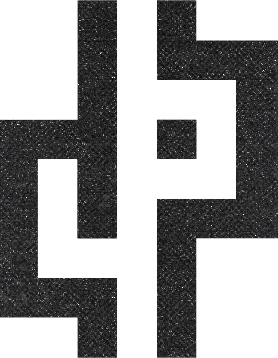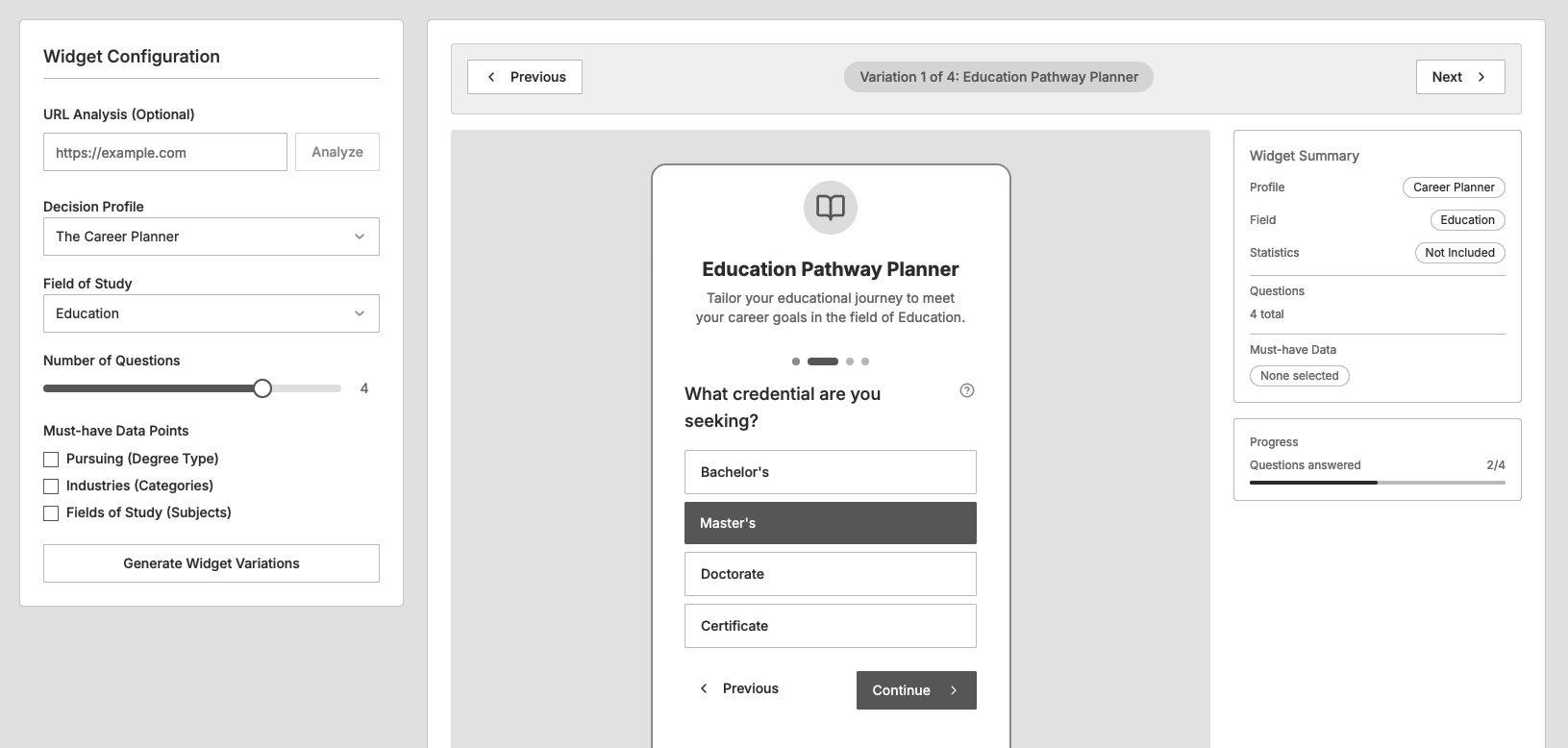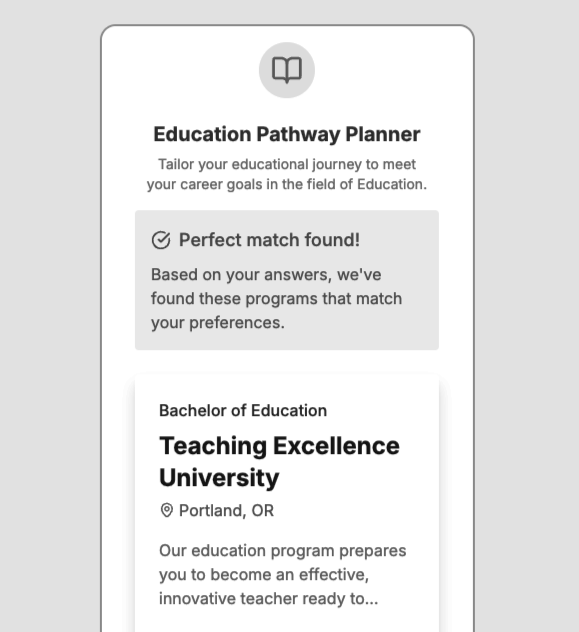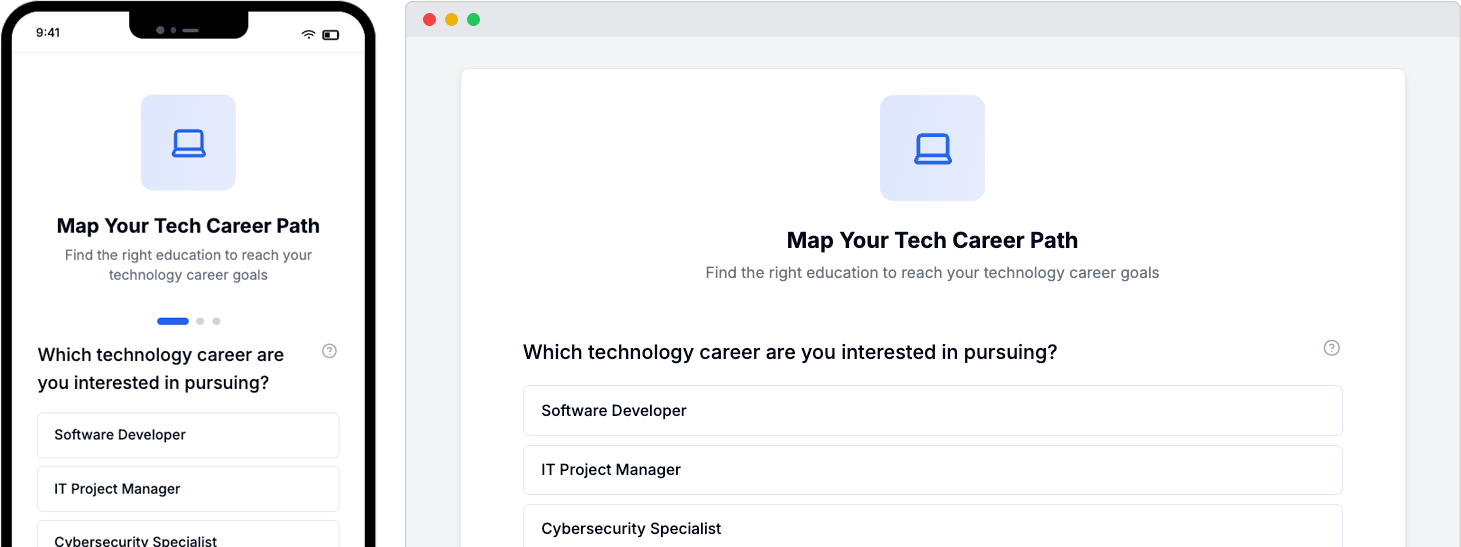Widget Builder: Rapid Concept Generator
Turning search intent into personalized student experiences: How a configurable widget system boosted engagement, reduced engineering time, and reshaped our ideation process.
Project Overview
Red Ventures Education runs digital platforms helping students explore higher education pathways aligned with their career goals and lifestyle needs. We connect students with suitable programs and generate revenue when they contact partner colleges.
Challenges
Students struggled with our legacy tools that offered static, one-size-fits-all content failing to adapt to diverse needs, resulting in poor engagement.
Our team faced slow ideation processes without proper visualization tools or engineering independence to rapidly test and scale successful approaches.
Goals
Create faster, personalized exploration aligned with student intent and career goals, reducing friction and helping learners find relevant programs.
Build a system enabling teams to design, preview, and deploy personalized widgets with minimal engineering support – greatly shortening our launch cycles.
Solutions
We analyze search signals to identify student intentions (comparing careers, seeking affordable programs, or returning to school) and personalize widget questions accordingly. Transforming passive browsing into meaningful discovery.
For our team, we created a configurable widget builder with live previews, AI question generation, and profile-based logic. This tool gives non-engineers autonomy to design, test, and launch experiences quickly.
Results
+17% engagement with profile-aligned widgets.
+8% conversion uplift → thousands of additional leads per quarter.
70% fewer engineering hours per iteration.
50% faster launch cycles, cutting time-to-market from weeks to days.
My Role: Product Strategy Lead. Facilitated workshops, defined system architecture, built MVP using Vercel’s V0, and guided cross-functional iterations.
Audience: Prospective higher education students exploring their options, along with our internal team of designers, content strategists, marketers, and engineers who create and test widgets.
Timeline: Summer 2025
One-size-fits-all Degree Quiz
Personalized Widgets
Discovery
Discovery research informed both the editorial widgets students interacted with on article pages and the internal widget builder teams used to design and deploy those widgets.
We began by mapping the student decision journey and diagnosing friction in lead-gen experiences. To ground design decisions, we combined prior student interviews, analytics review of editorial content, SERP-driven archetype analysis, and a competitive audit of degree exploration tools. Cross-functional workshops helped us align requirements for both audiences.
For Students (Behavioral Needs)
Previous unmoderated research (24 participants, screened for prospective online learners) focused on personalization preferences. Participants were asked open-ended prompts such as “What would make this feel trustworthy?” and “How would you want results tailored to you?”
Of the 24 Participants, 71% liked the idea of personalization for a tailored results experience. Key takeaways:
Convenient to see results filtered according to their responses
Willing to share personal info when it leads to highly personalized results
Saves time otherwise spent researching
Clear hierarchy with familiar, lightweight interactions and data visualizations
Define
We synthesized student needs (personalization, convenience, clarity, interactivity) and team requirements (configuration, interaction library, AI tooling, attribution) into design requirements.
Our analytics team studied SERP data to identify common search patterns and student intent. We translated these findings into decision profiles—archetypes matching intent signals like career exploration, salary comparisons, affordability, and flexibility to specific widget content presets.
Widget Builder Requirements
We defined key requirements for the Widget Builder that bridged research findings to concrete features:
URL-based properties – enter a URL and builder auto-adjusts properties to match context
Decision profile selection – SERP-driven archetypes with question types:
Cash Seeker → Salary, Value, or Goal-Focused
Decided Career → Goal, Field, or Partner-Focused
Career Planner → Goal, Field, or Value-Focused
Program Comparer → Value, Field, or Salary-Focused
Field of study – domain specification for widget logic
Question Controls – question count and style options
Manual entry – custom question input for creative flexibility
Constraints – Limited engineering required Vercel's V0 for prototyping.
Design
In just a few hours, I was able to build a low-fidelity prototype with V0 (below), which allowed for fast and candid stakeholder feedback before investing an additional 6–7 hours to refine a higher-fidelity build.
MVP Highlights
AI-driven question generation reduced manual scripting, giving editors more time to focus on content strategy.
Real-time previews reduced QA cycles, enabling faster iteration across device types. Feedback loops aligned UX, content, and analytics teams to a shared evaluation framework.
Based on feedback from participants, we incorporated more engaging question styles (prioritization, multi-select, nested, and interactive visualizations) while maintaining a simple design.
Copy-paste deployment allowed launches with a single engineer, minimizing development overhead.
Manual question entry so that editors can add, remove, or reorder questions, see previews, and ensure each widget matches unique editorial needs before deployment.
Question type selection based on decision profiles let us more precisely refine and tailor the widget’s focus, optimizing its strategic direction and effectiveness in serving student goals.
Design Validation
Internal Usability Testing – A cross-functional group of designers, engineers, and content strategists validated the design internally, prompting minor improvements.
Accessibility checks validated focus order, contrast, and keyboard/touch interactions.
Delivery
The V0 prototype was handed off to engineering for integration into our internal system and connection with our proprietary analytics dashboard. Engineering replicated the prototype in a secure environment, enabling advanced tracking and performance analysis.
The MVP experience consisted of new widget experiences for our editorial pages and the widget builder tool for teams. Collaboration across engineering, marketing, design, and editorial was supported through clear documentation, training, and demos.
Execution
Biweekly launches with single-engineer support.
Internal widget gallery for review and reuse.
Personalized delivery of student-facing widgets, dynamically adapting to intent signals and career goals.
Analytics pipeline improved visibility into engagement data, connecting widget type to conversion.
Secure environment ensured precise tracking and feedback loops.
Process clarity reinforced through documentation and knowledge sharing across teams.
Our system transformed static listings into interactive widgets, boosting engagement and accelerating experimentation. Teams now deploy personalized experiences in hours instead of weeks, improving relevance for students while enabling rapid iteration.
Student-Centered Impact
Metrics were collected via controlled A/B testing over a 6-week period:
+17% more engagement (people interacted more and spent more time on pages, tested with about 40,000 visits)
+8% more conversions (increase in students who submitted their information versus the control)
A follow-up survey of 50 students revealed the following qualitative feedback:
Faster, more relevant exploration reduced frustration
Time-saving tailored results cut research effort
Increased willingness to share personal info in exchange for personalized recommendations
Students gravitated toward interactive widgets, showing a preference for layered, expressive response options
Results
“After answering just a few questions, I found programs that fit both my budget and career aspirations—it made my search so much easier.”
Team-Centered Impact
70% fewer engineering hours per concept (time-tracking vs. legacy builds)
50% faster iteration cycles (average time from idea to launch)
Cross-team alignment — design, content, and analytics teams spoke a shared language.
Scalable experimentation — modular system enabled continuous test-and-learn.
Increased willingness to share personal info in exchange for personalized recommendations
Students gravitated toward interactive widgets, showing a preference for layered, expressive response options
“The speed at which we can generate and test new ideas has completely changed how our team works. I love the live preview.”














